For the last couple of days, I gave a little rest to my “wandering shoes” and indulged myself into a lethargic lifestyle of late night movies, lazy mornings, skipping breakfast and snoring or gazing the “idiot box” all day. But soon the “travel bug” sneaked into my torpid comforts and stimulated my core to stand up for my love for travelling.
Infused with a sense of motivation, I geared up once again with my “wandering shoes” for yet another jaunt to explore the mysteries of the Old Fort or famously known as Purana Qila with Delhi Karavan. Although, I was running a bit late on schedule, yet the group members were patient enough to welcome late comers like me. With a small introduction of each participant, the group ambled on the slightly steep passage towards the giant doors of the fort.

Bada Darwaza
The giant doors accompanied by tough walls which once were highly guarded with royal soldiers seemed embracing each of its visitors with doors wide open. The entrance also known as “Bada Darwaza” (Giant Door) is a beautiful yet robust piece architecture aimed at both welcoming its visitors and protecting the population against the attack during the medieval time. The elegant Jharokas (cantilevered enclosed openings) with extended pavilions further enhanced the beauty of this medieval entrance.

Ambling along the walls of the Fort
The group entered the fort and we walked along with the walls before finally resting our base on lush green grasses in precincts of the fort. The only person standing was Asif, the founder of Delhi Karavan elaborating the medieval history of the site. He coupled his sessions of history with exciting anecdotes which made it more interesting. I felt like sitting in school for a lesson on medieval history, the only difference being that during those time I eagerly waited for the bell to do its job.

Audience listening to history lessons of Asif and Vikram Sir
The Old Fort (known as Dinpanah during medieval times) was constructed by Mughal Emperor Humayun in 1533 but soon it was captured by Sher Shah Suri who made several additions to the existing structures. Although, the fort saw the reign of two great rulers but still it is termed as “unlucky”. The reason being both the rulers who ruled through the Old Fort died soon after they captured this fort. But its fateful history does not hinder the joy of the visitors who throng the place.
As soon as Asif completed the medieval history session, the group was joined by yet another history lover and founder of “Youth for Heritage” Vikramjt Singh Rooprai who enunciated the history of the place from another perspectives. He took us into the era of Mahabharata and Pandavas and Kaurvas. The site where the remains of Old Fort stand today has a perennial history of habitation linking to the ancient city of Indraprastha. The detailed document of administration of Emperor Akbar i.e. Ain-E-Akbari also makes a reference to the existence of fort of Pandavas and Kaurvas prior to Old Fort. The previous excavations have revealed the remains different cultures much before the Mughals. In an on-going excavation in the area, an ancient Vishnu sculpture, pottery, coins etc. have surfaced hailing to the period of Guptas.
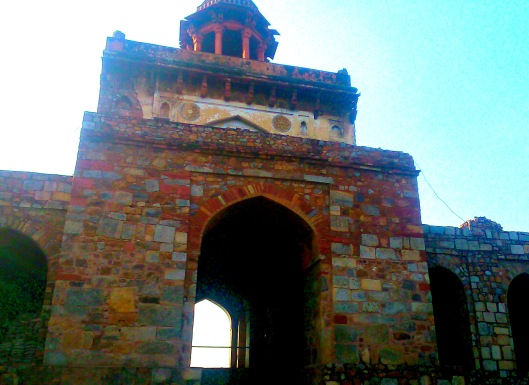
Talaqi Gate
Vikram Sir gave some contrasting facts which challenges the some well-known historical information perceived by general public which leave a scope for further research open .

Some ruined parts of Forts
Finally, the history lessons came to an end and the real wandering started. I started moving with the group along with the wall and soon reached to another entrance of the fort known as “Talaki Gate” often called “forbidden gate” as Sher Shah Suri is believed to have left for the battle from this gate and never returned back. The gate is similar to the “Bada Darwaza” and its features are reminiscent of Rajasthan Forts. Apart from this, there is one more entrance to the Old Fort known as “Humayun Gate” probably named as his tomb was visible from there.
QILA-E-KUHNA
The group further meandered to some other old remains of the Old Fort’s walls and then through the meadows disturbing some love birds who had comforted themselves in seclusion of the place until we finally reached “Qila-E-Kuhna” which literally means “the mosque of the old fort”.

Qile-E-Kuhna mosque
Built in 1541 by Sher Shah, the mosque is masterpiece among the medieval structures in the old fort. We approached the mosque from rear side and I didn’t realize it was a mosque until I reached in frontage. The rear side of the mosque built with yellow and red sandstone with two extended pavilions from the walls really mesmerized me with its magical charm. The most appealing feature of the rear side was the octagonal turret with two stories made from red sandstone and the top one from yellow sandstone. It had arch openings with beautiful designs which totally engrossed me.
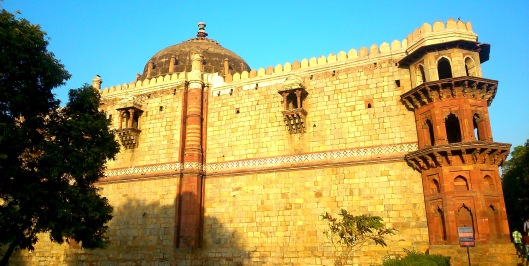
Rear Wall of the Mosque

Beautiful turret on the rear side of mosque wall
When I reached the front side, it was almost similar to “Jamali Kamali” mosque of Mehrauli Archaeological Park yet it colours looked more vibrant to me. The front façade has remarkable design carved on red sandstone, white marbles and tiles. The boundary of arch was decorated by lotus buds design which was also seen on the prayer walls.

Front facade of mosque
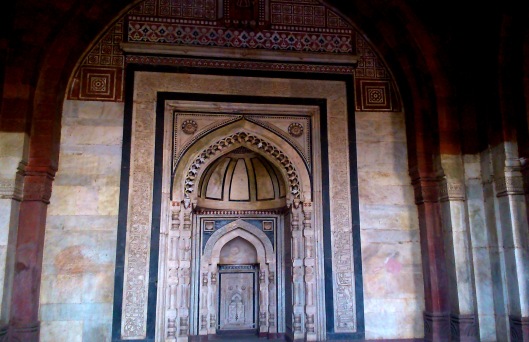
Prayer Wall of Mosque
The interior of mosque is also as beautiful as its facade with carved spandrels and small opening along the dome which allowed sunlight to enter the mosque. The main chamber of mosque showcased a star symbol inside a circle with either lotus buds or tulip which the participants confused with “Star of David”. However, the doubt was soon cleared by Vikram Sir who explained that it was cosmos sign used in Hindu religion extensively. It is believed since the workers who built the structure also included Hindus, therefore, some features of their architecture might have crept in. I have personally seen them in many historical sites across Delhi. It is symbol of religious tolerance among the medieval masses contrary to present times.
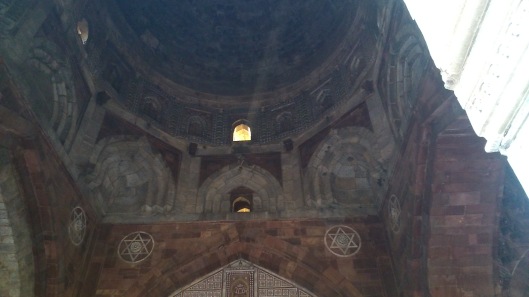
Inside of Qile-E-Kuhna mosque
Apart from clearing the doubts, Vikram Sir also revealed that our ancestors used rice paste, jaggery, black lentils, lime and similar other edible ingredients for patching/holding stones (similar to present day cement) which left me astonished as it was a complete “out of the blue” and unbelievable fact for me. Such facts and remarkable ancient structures compels me to salute their depth of knowledge and often raises a question in my mind “Are we really technologically advanced than our ancestor or there is a missing link”?
SHER MANDAL
After posing for a group photograph at the mosque, all of us moved further and found some excavation going around the site. The newly discovered ancient relics were nicely kept separated on ground probably on the basis of the period to which they belonged to. I was told it was just the first layer which has been excavated and no one knows how many more stories are buried down there.
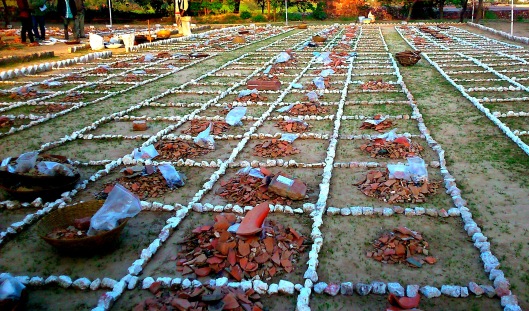
Current Excavation at Purana Qila
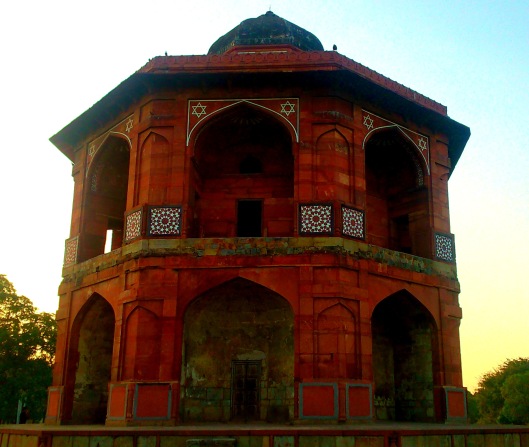
Sher Mandal
A little more wandering and we were in front of another monument “Sher Mandal”. The two storeyed octagonal structure built from red sandstone and decoration of white marble was believed to be pleasure retreat of Sher Shah which was later converted into a library by Humayun. However, it is more famous among the historians for the tragic death of Humayun who is believed to have died after falling from the stairs.
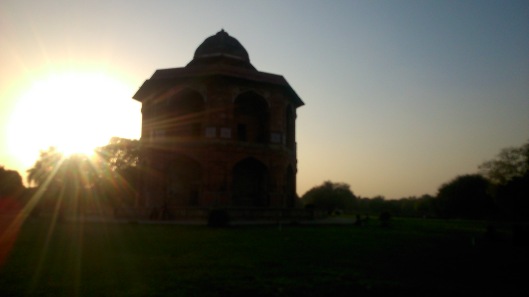
Sher Mandal
HAMAAM
Just opposite to the Sher Mandal are the remains of the ancient bath house known as “Hamaam” which means a place for better health. It is more like the modern day spa with a series of rejuvenating treatments available for better health and it is said most important decision of the administration were taken here.

Hamam
The mere mention of the word spa commenced the gossiping among the ladies and they got so involved in their spa memoirs that they even ignored the explanation being given by Asif and Vikam Sir. At last, ladies had to be requested to surrender their spa gossips for the time being.

Lush green lawns in the precincts of Fort

Kaushal Mathpal is an Advocate practicing in Delhi Courts in India but also has a flair for travelling. When he’s not in a courtroom, he enjoys exploring various parts of India and the surrounding region. He also writes on his blog http://rediscoveryourdreams.wordpress.com/ and you can follow him on Twitter @KaushalMathpal.








